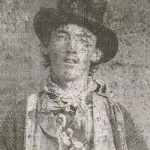Billy the Kid Deserves No Pardon
 Who in their right minds would consider a posthumous pardon for Billy the Kid – a homicidal psychopath who boasted that he'd killed 21 men?
Who in their right minds would consider a posthumous pardon for Billy the Kid – a homicidal psychopath who boasted that he'd killed 21 men?
On the eve of his quitting after eight years as New Mexico’s governor, Bill Richardson announced he was denying a pardon to the infamous outlaw, Billy the Kid.
Good Lord!
Who in their right minds would consider a posthumous pardon to Billy the Kid – a homicidal psychopath who boasted he’d killed one man for every year of his life when he was shot in 1881 at age 21. Billy’s only virtue was that he smiled a lot, laughed as he killed, was ineffably polite, and generally good-humored. A happy killer.
In a way he seems to have personified the Al Capone saying: “You can go a long way with a smile. You can go a lot further with a smile and a gun.”
Born in Brooklyn in 1859 as Billy McCarty, or Bonney, his mother moved to New Mexico and, according to The Gunfighters, one of a Time-Life series of Old West books, Billy the Kid was romanticized more than his record as a gun fighter warranted.
Other gunfighters of the time killed more ruthlessly but with less publicity: Wes Hardin, 44 killed; Clay Allison, at least 15; Bill Longley, 32 shot, including one man for snoring.
Billy the Kid apologists (and there are some) claim he “only” killed nine. Others say far more than 21 (the Kid’s figure). Every one of his victims was murdered – bush-whacked, ambushed, dry-gulched. None in one of those Hollywood gun fights.
Pat Garrett, the sheriff who befriended and killed him in 1881, took over the Billy the Kid legend. Teaming up with journalist Ashum Upsom, Garret produced The Authentic Life of Billy the Kid which purported to “correct the thousands of false statements” about Billy that appeared in the press and dime novels.
In fact, Garrett invented feats of the Kid which were accepted as gospel, coming as they did from the man who killed him.
As it was, Billy was something of an escape artist. Small hands enabled him to slip easily out of handcuffs. He was part of the bloody Lincoln County range war over trading and cattle rights, and in 1879 had a secret meeting with New Mexico Governor Lew Wallace and negotiated an amnesty for all his crimes in return for supplying evidence against others for Lincoln County violence. “I have no wish to fight anymore,” wrote Billy.
Gov. Wallace (author of the novel Ben Hur) apparently reneged on his amnesty promise after Billy the Kid surrendered himself. In 1881 while in jail, six months before he died, Billy wrote politely to the governor: “I would like to see you for a few moments if you can spare time,” signing it “Yours Respect. W.H.Bonney. His handwriting is precise.
The governor didn’t reply – so Billy escaped. Once again.
After killing Billy, Garrett mused: “In his most savage and dangerous moods his face always wore a smile. He ate and laughed, drank and laughed, rode and laughed, talked and laughed, fought and laughed – and killed and laughed.”
Within 10 months of his death, eight novels, which sold over a million copies, were written romanticizing his career. A cottage industry was born.
Since 1911, there’ve been at least 47 movies about Billy the Kid, and four TV dramas or documentaries. Some better known movies include Young Guns, One-Eyed Jacks (Marlon Brando); The Left Handed Gun (Paul Newman); The Outlaw (Howard Hughes); Billy the Kid (Robert Taylor).
Still, there’s no logical reason to posthumously pardon him – unless you think Charlie Manson also got a raw deal.
Tweet